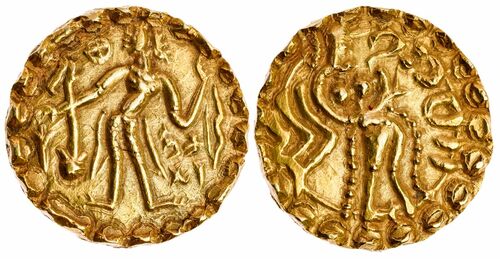
Auction: 23109 - Spink Numismatic e-Circular 29: Indian and Islamic Coins Featuring 'A Gentleman's Collection of Sri Lankan Coins' Part II - e-Auction
Lot: 8178
(x) Ancient India, Post-Gupta Bengal, Samatata region, "Sri Kumara" (Bhaskaravarman) (c.640- 655), gold Dinar, 5.82g, kingly figure standing left holding a bow right and an arrow left, a standard topped by a conch shell in left field, a chakra (wheel) above, Brahmi legend ku ma ra in right field, rev. stylized female figure wearing cloak standing right, pseudo legend in right field (Group F, N. Rhodes (ed. W. Bertsch), "The Coinage of Samatata", JONS 228, Summer 2016, pp.9-15), small flan crack between king's legs, uncirculated, gem
After the fall of the Gupta Empire in the 6th century, the history of Bengal is unclear. It is only relatively recently that gold coins of this type have been found in south eastern Bengal, in the area covered by ancient Samatata. Their design is clearly derived from that of the Guptas (or earlier Kushans), with a standing kingly figure on the obverse and a deity or goddess on the reverse. Some of them bear legends in the right field of the obverse that may shed light on the early history of Samatata. In the case of this coin the legend Sri Kumara may refer to the king of neigbouring Kamarupa, Bhaskaravarman, who used this as his common name. He is said to have ruled all of eastern Bengal after the death of his rival Sasanka, until he himself died in 655.
The references in this listing are taken from a posthumous paper by Nicholas Rhodes, "The Coinage of Samatata" edited by Wolfgang Bertsch, published in the Journal of the Oriental Numismatic Society #228, Summer 2016 https://www.orientalnumismaticsociety.org/archive/ONS_228.pdf#page=15
Subject to 5% tax on Hammer Price in addition to 20% VAT on Buyer’s Premium.
Estimate
£900 to £1,200
Starting price
£700




